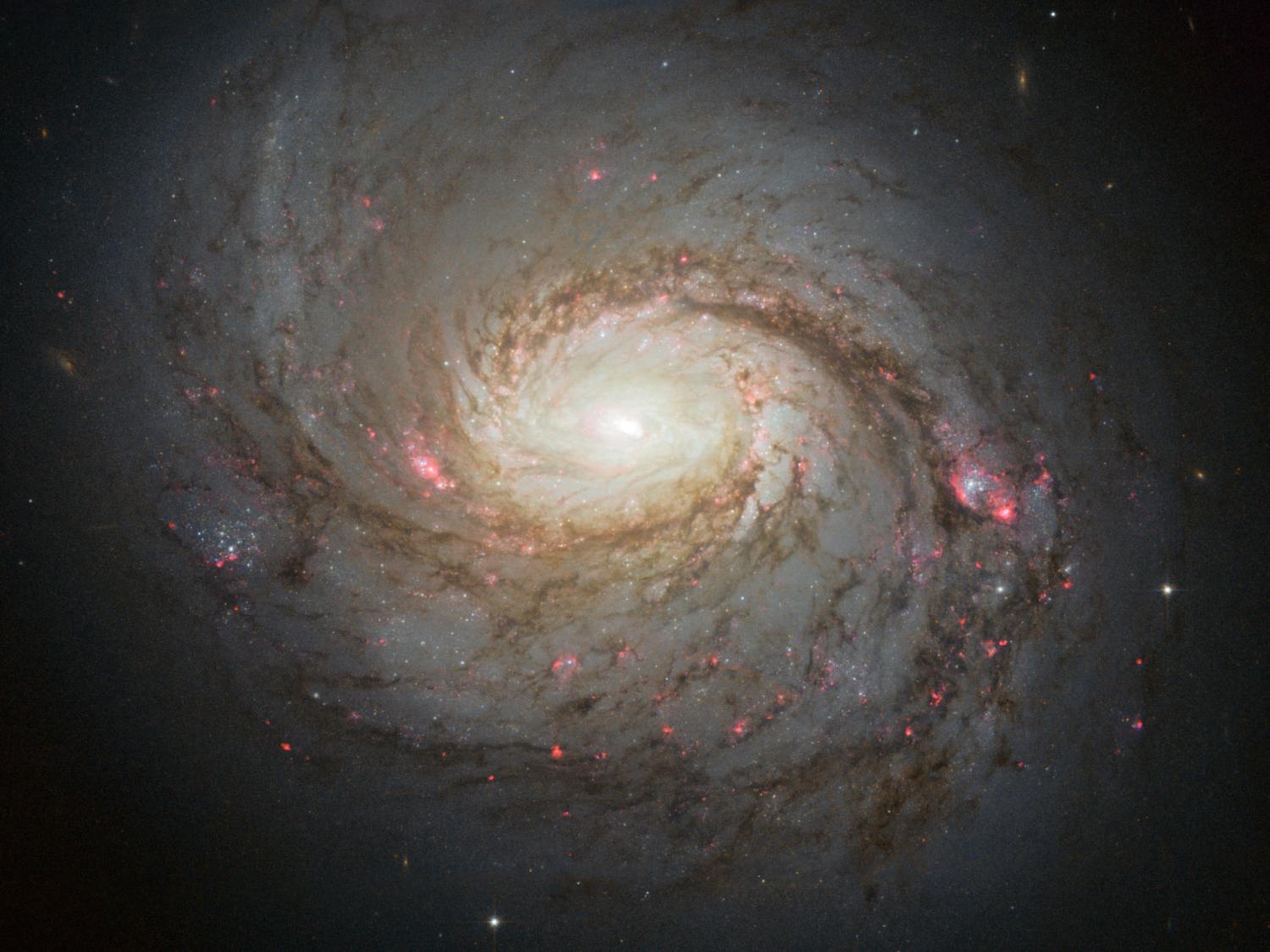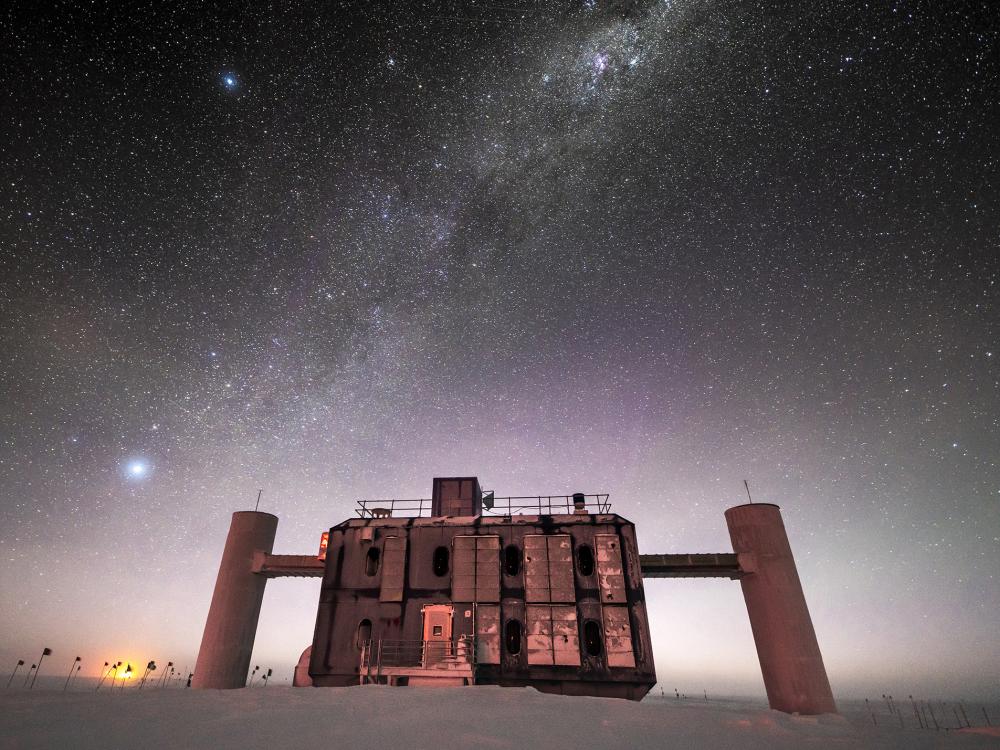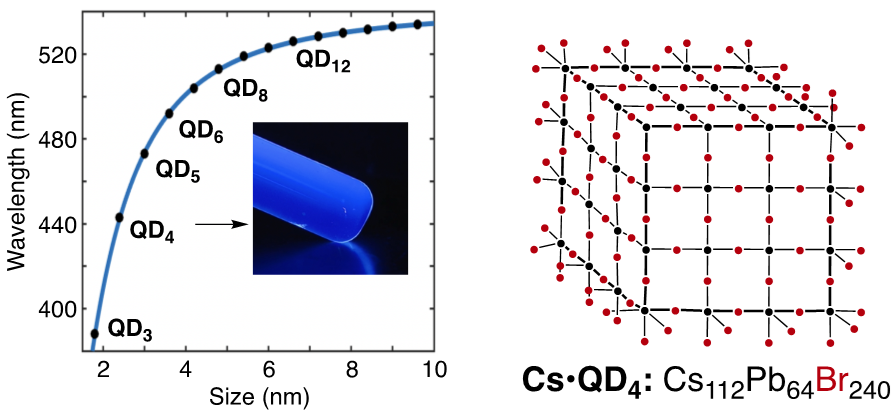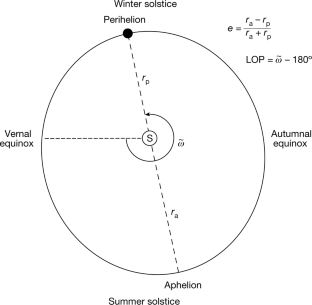2022-11-08 ペンシルベニア州立大学(PennState)

Hubble image of the spiral galaxy NGC 1068. Credit: NASA / ESA / A. van der Hoeven. All Rights Reserved.

Front view of the IceCube Lab at twilight, with a starry sky showing a glimpse of the Milky Way overhead and sunlight lingering on the horizon. Credit: Martin Wolf, IceCube/NSF. All Rights Reserved.
この検出は、南極大陸の南極点近くの地下1.5〜2.5kmにある、10億トンの氷でできた巨大なニュートリノ望遠鏡、アイスキューブ・ニュートリノ観測所によってなされた。
NGC 1068は、私たちの故郷の銀河と同じように、棒渦巻銀河で、緩く巻いた腕と比較的小さな中心部の膨らみをもっている。しかし、私たちの天の川銀河とは異なり、NGC1068は活動的な銀河で、放射線のほとんどは星によって生み出されているわけではありません。その代わり、銀河の中心部は、太陽の約1500万倍、銀河の中心にある不活性ブラックホールの4倍もの質量をもつブラックホールに落ち込む物質によって、全電磁波帯にわたって輝いている。
<関連情報>
- https://www.psu.edu/news/eberly-college-science/story/icecube-neutrinos-give-first-glimpse-inner-depths-active-galaxy/
- https://icecube.wisc.edu/news/press-releases/2022/11/icecube-neutrinos-give-us-first-glimpse-into-the-inner-depths-of-an-active-galaxy/
- https://www.science.org/doi/10.1126/science.abg3395
近傍活動銀河NGC1068からのニュートリノ放射の証拠 Evidence for neutrino emission from the nearby active galaxy NGC 1068
IceCube Collaboration,R. Abbasi,M. Ackermann,J. Adams,J. A. Aguilar,M. Ahlers,M. Ahrens,J. M. Alameddine,C. Alispach,A. A. AlvesJr.,N. M. Amin,K. Andeen,T. Anderson,G. Anton,C. Argüelles,Y. Ashida,S. Axani,X. Bai,A. Balagopal V.,A. Barbano,S. W. Barwick,B. Bastian,V. Basu,S. Baur,R. Bay,J. J. Beatty,K.-H. Becker,J. Becker Tjus,C. Bellenghi,S. BenZvi,D. Berley,E. Bernardini,D. Z. Besson,G. Binder,D. Bindig,E. Blaufuss,S. Blot,M. Boddenberg,F. Bontempo,J. Borowka,S. Böser,O. Botner,J. Böttcher,E. Bourbeau,F. Bradascio,J. Braun,B. Brinson,S. Bron,J. Brostean-Kaiser,S. Browne,A. Burgman,R. T. Burley,R. S. Busse,M. A. Campana,E. G. Carnie-Bronca,C. Chen,Z. Chen,D. Chirkin,K. Choi,B. A. Clark,K. Clark,L. Classen,A. Coleman,G. H. Collin,J. M. Conrad,P. Coppin,P. Correa,D. F. Cowen,R. Cross,C. Dappen,P. Dave,C. De Clercq,J. J. DeLaunay,D. Delgado López,H. Dembinski,K. Deoskar,A. Desai,P. Desiati,K. D. de Vries,G. de Wasseige,M. de With,T. DeYoung,A. Diaz,J. C. Díaz-Vélez,M. Dittmer,H. Dujmovic,M. Dunkman,M. A. DuVernois,E. Dvorak,T. Ehrhardt,P. Eller,R. Engel,H. Erpenbeck,J. Evans,P. A. Evenson,K. L. Fan,A. R. Fazely,A. Fedynitch,N. Feigl,S. Fiedlschuster,A. T. Fienberg,K. Filimonov,C. Finley,L. Fischer,D. Fox,A. Franckowiak,E. Friedman,A. Fritz,P. Fürst,T. K. Gaisser,J. Gallagher,E. Ganster,A. Garcia,S. Garrappa,L. Gerhardt,A. Ghadimi,C. Glaser,T. Glauch,T. Glüsenkamp,A. Goldschmidt,J. G. Gonzalez,S. Goswami,D. Grant,T. Grégoire,S. Griswold,C. Günther,P. Gutjahr,C. Haack,A. Hallgren,R. Halliday,L. Halve,F. Halzen,M. Ha Minh,K. Hanson,J. Hardin,A. A. Harnisch,A. Haungs,D. Hebecker,K. Helbing,F. Henningsen,E. C. Hettinger,S. Hickford,J. Hignight,C. Hill,G. C. Hill,K. D. Hoffman,R. Hoffmann,B. Hokanson-Fasig,K. Hoshina,F. Huang,M. Huber,T. Huber,K. Hultqvist,M. Hünnefeld,R. Hussain,K. Hymon,S. In,N. Iovine,A. Ishihara,M. Jansson,G. S. Japaridze,M. Jeong,M. Jin,B. J. P. Jones,D. Kang,W. Kang,X. Kang,A. Kappes,D. Kappesser,L. Kardum,T. Karg,M. Karl,A. Karle,U. Katz,M. Kauer,M. Kellermann,J. L. Kelley,A. Kheirandish,K. Kin,T. Kintscher,J. Kiryluk,S. R. Klein,R. Koirala,H. Kolanoski,T. Kontrimas,L. Köpke,C. Kopper,S. Kopper,D. J. Koskinen,P. Koundal,M. Kovacevich,M. Kowalski,T. Kozynets,E. Kun,N. Kurahashi,N. Lad,C. Lagunas Gualda,J. L. Lanfranchi,M. J. Larson,F. Lauber,J. P. Lazar,J. W. Lee,K. Leonard,A. Leszczyńska,Y. Li,M. Lincetto,Q. R. Liu,M. Liubarska,E. Lohfink,C. J. Lozano Mariscal,L. Lu,F. Lucarelli,A. Ludwig,W. Luszczak,Y. Lyu,W. Y. Ma,J. Madsen,K. B. M. Mahn,Y. Makino,S. Mancina,I. C. Mariş,I. Martinez-Soler,R. Maruyama,K. Mase,T. McElroy,F. McNally,J. V. Mead,K. Meagher,S. Mechbal,A. Medina,M. Meier,S. Meighen-Berger,J. Micallef,D. Mockler,T. Montaruli,R. W. Moore,R. Morse,M. Moulai,R. Naab,R. Nagai,R. Nahnhauer,U. Naumann,J. Necker,L. V. Nguyen,H. Niederhausen,M. U. Nisa,S. C. Nowicki,D. Nygren,A. Obertacke Pollmann,M. Oehler,B. Oeyen,A. Olivas,E. O’Sullivan,H. Pandya,D. V. Pankova,N. Park,G. K. Parker,E. N. Paudel,L. Paul,C. Pérez de los Heros,L. Peters,J. Peterson,S. Philippen,S. Pieper,M. Pittermann,A. Pizzuto,M. Plum,Y. Popovych,A. Porcelli,M. Prado Rodriguez,P. B. Price,B. Pries,G. T. Przybylski,C. Raab,J. Rack-Helleis,A. Raissi,M. Rameez,K. Rawlins,I. C. Rea,A. Rehman,P. Reichherzer,R. Reimann,G. Renzi,E. Resconi,S. Reusch,W. Rhode,M. Richman,B. Riedel,E. J. Roberts,S. Robertson,G. Roellinghoff,M. Rongen,C. Rott,T. Ruhe,D. Ryckbosch,D. Rysewyk Cantu,I. Safa,J. Saffer,S. E. Sanchez Herrera,A. Sandrock,J. Sandroos,M. Santander,S. Sarkar,S. Sarkar,K. Satalecka,M. Schaufel,H. Schieler,S. Schindler,T. Schmidt,A. Schneider,J. Schneider,F. G. Schröder,L. Schumacher,G. Schwefer,S. Sclafani,D. Seckel,S. Seunarine,A. Sharma,S. Shefali,M. Silva,B. Skrzypek,B. Smithers,R. Snihur,J. Soedingrekso,D. Soldin,C. Spannfellner,G. M. Spiczak,C. Spiering,J. Stachurska,M. Stamatikos,T. Stanev,R. Stein,J. Stettner,A. Steuer,T. Stezelberger,R. Stokstad,T. Stürwald,T. Stuttard,G. W. Sullivan,I. Taboada,S. Ter-Antonyan,S. Tilav,F. Tischbein,K. Tollefson,C. Tönnis,S. Toscano,D. Tosi,A. Trettin,M. Tselengidou,C. F. Tung,A. Turcati,R. Turcotte,C. F. Turley,J. P. Twagirayezu,B. Ty,M. A. Unland Elorrieta,N. Valtonen-Mattila,J. Vandenbroucke,N. van Eijndhoven,D. Vannerom,J. van Santen,S. Verpoest,C. Walck,T. B. Watson,C. Weaver,P. Weigel,A. Weindl,M. J. Weiss,J. Weldert,C. Wendt,J. Werthebach,M. Weyrauch,N. Whitehorn,C. H. Wiebusch,D. R. Williams,M. Wolf,K. Woschnagg,G. Wrede,J. Wulff,X. W. Xu,J. P. Yanez,S. Yoshida,S. Yu,T. Yuan,Z. Zhang,P. Zhelnin
Science Published:3 Nov 2022
DOI: 10.1126/science.abg3395
Nearby active galaxy emits neutrinos
Observations have shown a diffuse background of high-energy neutrinos, which is known to be of extragalactic origin. However, it has been difficult to identify individual sources that contribute to this background. The IceCube Collaboration reanalyzed the arrival directions of astrophysical neutrinos and then searched for point sources (see the Perspective by Murase). They identified evidence for neutrino emission from NGC 1068 (also known as Messier 77), a nearby active galaxy. Its properties are quite different from TXS 0506+056, which was found to be a neutrino source in 2018, leading the investigators to suggest that there might be more than one population contributing to the neutrino background. —KTS
Abstract
A supermassive black hole, obscured by cosmic dust, powers the nearby active galaxy NGC 1068. Neutrinos, which rarely interact with matter, could provide information on the galaxy’s active core. We searched for neutrino emission from astrophysical objects using data recorded with the IceCube neutrino detector between 2011 and 2020. The positions of 110 known gamma-ray sources were individually searched for neutrino detections above atmospheric and cosmic backgrounds. We found that NGC 1068 has an excess of 79+22−20 neutrinos at tera–electron volt energies, with a global significance of 4.2σ, which we interpret as associated with the active galaxy. The flux of high-energy neutrinos that we measured from NGC 1068 is more than an order of magnitude higher than the upper limit on emissions of tera–electron volt gamma rays from this source.



